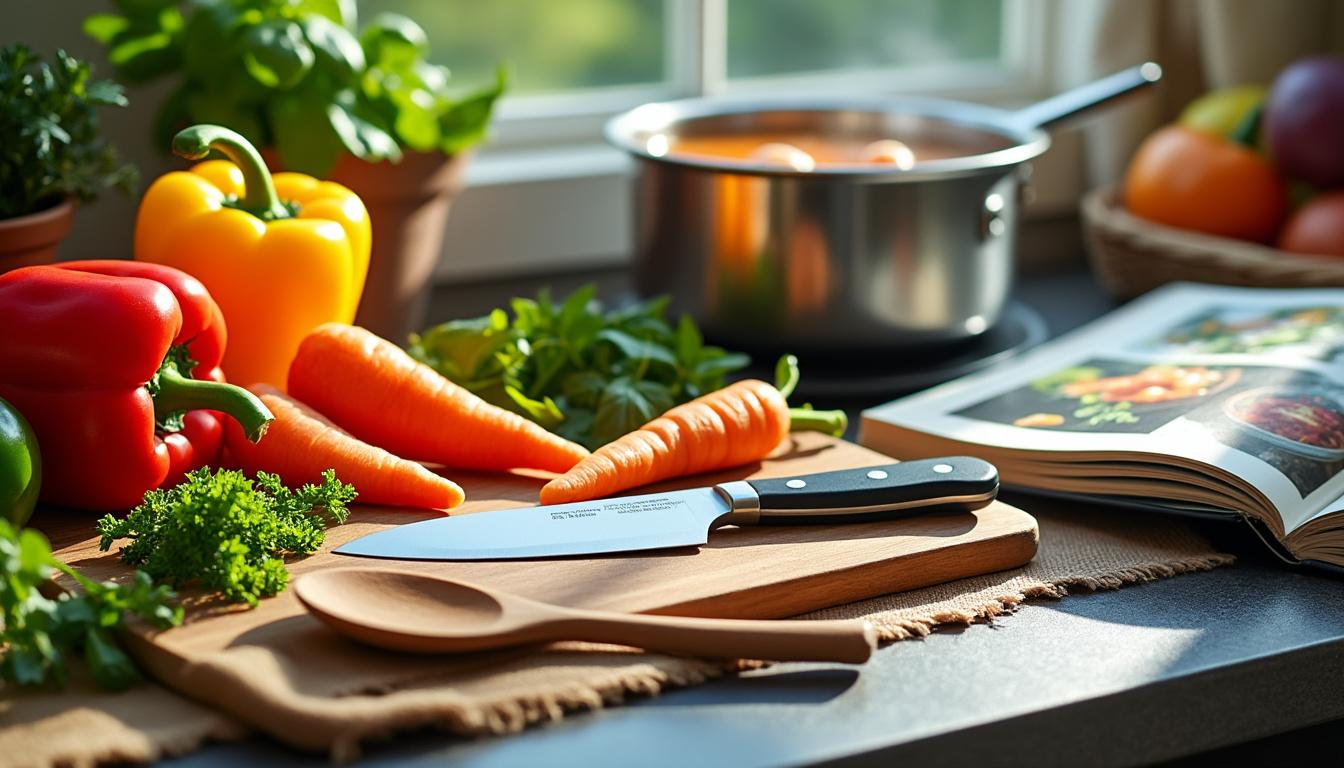Mastering the art of cooking requires more than following recipes; it demands an understanding of fundamental techniques, attention to detail, and the right tools. Elevating culinary skills is about turning simple ingredients into memorable dishes with precision and creativity. By embracing essential cooking tips that emphasize preparation, seasoning, and mastering kitchen equipment, home chefs can transform their cooking experience and impress even the most discerning palates. These insights build a foundation of confidence and skill that allows for culinary exploration beyond the typical meal.
Mastering Knife Skills for Professional-Level Precision and Safety
Fundamental to any culinary advancement is the mastery of knife skills. Sharp, well-maintained knives not only improve the quality of cuts but also increase safety in the kitchen. Dull knives require more force, which heightens the risk of slips and injuries. Investing in premium brands such as All-Clad, Cuisinart, or Le Creuset for kitchen knives can provide superior balance, long-lasting sharpness, and durability, transforming meal preparation into a seamless process.
Equally important is the technique of cutting ingredients evenly. Uniform pieces ensure consistent cooking times and harmonious textures in the final dish. A professional chef understands that an evenly diced onion or symmetrically sliced vegetable leads to an even sear and balanced flavor development. For example, sautéing uniformly cut potatoes produces both a consistent golden crust and a fluffy interior.
Essential tips for improving knife use include:
- Regularly sharpening knives to maintain a fine edge and avoid accidents.
- Utilizing the appropriate knife for the task (e.g., chef’s knife for chopping, paring knife for peeling).
- Mastering cutting techniques such as the rocking chop and julienne for speed and precision.
Businesses specializing in kitchenware such as OXO and Misen offer affordable, ergonomic knives that balance function with form, making them excellent choices for home cooks looking to improve safety and efficiency.
| Knife Type | Use | Key Feature |
|---|---|---|
| Chef’s Knife | Chopping, dicing, slicing | Versatile blade, 8-10 inches long |
| Paring Knife | Peeling, trimming, detailed cuts | Short blade, precise control |
| Serrated Knife | Cutting bread, tomatoes | Saw-like edge |
Leveraging Cooking Tools and Equipment for Exceptional Outcomes
High-quality kitchen tools are the cornerstone of efficient cooking and consistent food quality. Despite many affordable options available, investing in trusted brands like KitchenAid for mixers or Calphalon for non-stick cookware elevates the cooking process by combining reliability with superior craftsmanship. For instance, a sturdy Le Creuset Dutch oven can handle everything from slow braised meats to artisan bread baking with even heat distribution.
Good tools improve not only the end result but also the cooking experience itself. Using premium pans such as those from Tfal or Lodge ensures better temperature control and reduces food sticking, leading to better flavor retention. When cooking on stovetops, pan crowding should be avoided; overcrowding reduces heat circulation and leads to uneven cooking. Professionals recommend cooking in batches when necessary to maintain texture and flavor.
Critical culinary tools and their advantages include:
- Stand mixers: Ideal for precise baking and dough preparation.
- Heavy-bottomed pans: Prevent hot spots, ideal for sautéing and searing.
- Quality cutlery: Enhances efficiency and presentation.
- Accurate measuring tools: Ensures consistent results, pivotal in baking.
| Tool | Brand Example | Key Benefit |
|---|---|---|
| Stand Mixer | KitchenAid | Precision mixing for doughs and batters |
| Cast Iron Skillet | Lodge | Superior heat retention and searing ability |
| Non-stick Pan | Tfal | Easy cleanup and reduced oil requirement |
Enhancing Flavor Through Understanding Seasoning and Ingredient Preparation
Flavor development is an art, and seasoning plays a critical role. One common mistake is waiting to season food only at the end. Instead, seasoning at various stages of cooking allows flavors to penetrate and develop a multi-dimensional profile. For example, seasoning proteins before searing builds a crust, while adjusting salt levels during boiling and simmering deepens taste complexity.
Salt acts as a primary enhancer and its application to boiling water when cooking pasta or vegetables is essential. This technique infuses the ingredients, elevating the overall taste. It is a quick, simple step that yields noticeable differences in dishes and treats vegetables better than plain water. Similarly, seasoning cold dishes more generously than hot ones compensates for the muted perception of flavors when chilled, ensuring vibrancy in salads or cold appetizers.
Additional seasoning tips encompass:
- Seasoning from a distance for even distribution and balance.
- Patting meat dry before seasoning to improve crust formation and flavor adhesion.
- Understanding which ingredients can be swapped without compromising chemical reactions, as explained in detail at trusted culinary resources.
| Seasoning Technique | Application | Effect |
|---|---|---|
| Layered seasoning | Throughout cooking process | Complex, deep flavor profiles |
| Salt in boiling water | For pasta, veggies | Enhanced natural flavor |
| Seasoning cold dishes heavily | Salads, cold appetizers | Balanced flavor despite cold temperature |
Optimizing Cooking Techniques and Timing for Consistent Results
Cooking times and temperature control are paramount in achieving mastery over dishes. Understanding the specific cook times for staple ingredients like chicken, onions, and root vegetables enables multitasking and recipe adjustments. For instance, knowing that chicken breast cooks faster than thighs informs cooking sequence and timing. Moreover, familiarity with your oven’s idiosyncrasies ensures better outcomes since appliances vary widely in heat distribution.
Another critical practice is avoiding overcrowding pans and baking sheets, which impedes heat circulation and leads to inconsistent cooking. Professionals recommend spacing food adequately or cooking in batches to preserve texture and flavor integrity. Additionally, allowing meat to rest after cooking is vital; resting times help juices redistribute, resulting in moist, flavorful cuts rather than dry or tough slices immediately after cooking.
- Learn and memorize common cook times for ingredients to improve kitchen efficiency.
- Practice spacing food properly in pans or on sheets.
- Let meat rest for at least five minutes to finish cooking and retain juices.
| Ingredient | Typical Cook Time | Notes |
|---|---|---|
| Chicken Breast | 20-25 minutes (oven at 375°F) | Cook until internal temp reaches 165°F |
| Onions (sautéed) | 5-7 minutes | Cook until translucent and tender |
| Root Vegetables (roasted) | 30-40 minutes at 400°F | Evenly cut pieces ensure uniform cooking |
Practical Recipe Management and Ingredient Selection for Home Kitchen Success
While technical skills and tools are crucial, managing recipes and selecting premium ingredients play indispensable roles in elevating culinary outcomes. Thoroughly reading and understanding a recipe prior to cooking prevents costly mistakes and stressful rushes. If unfamiliar ingredients arise, preparatory research or practice days ahead can integrate them smoothly into the cooking process.
Ingredient selection is equally vital. Fresh, high-quality produce such as ripened avocados, vibrant tomatoes, and fragrant herbs directly influence flavor intensity. Learning to pick ripe and flavorful items, whether from markets or specialty shops, will markedly enhance meal results. By focusing on basics—mastering simple dishes like scrambled eggs and homemade chocolate chip cookies—chefs create a strong foundation before tackling complex recipes such as Beef Wellington or croissants.
- Read recipes in full before beginning to anticipate timing and equipment needs.
- Choose fresh, ripe produce to maximize taste and texture.
- Start with basic dishes to build confidence before attempting elaborate preparations.
- Maintain notes on recipes to adjust seasoning and technique based on previous results.
| Practice Level | Recommended Dishes | Benefits |
|---|---|---|
| Beginner | Scrambled eggs, simple salads | Builds confidence and fundamental skills |
| Intermediate | Risotto, roasted chicken | Introduces more complex timing and seasoning |
| Advanced | Beef Wellington, croissants | Challenges precision and multitasking |
The knowledge imparted here aligns with expert advice featured on renowned culinary platforms and by top chefs worldwide, emphasizing that cooking is a continual learning journey enriched by precision and practice.
Frequently Asked Questions About Elevating Culinary Skills
-
How often should I sharpen my kitchen knives?
It is advisable to sharpen knives every few months depending on usage frequency and hone the blade regularly to maintain sharpness and safety.
-
Can I substitute ingredients in baking recipes?
Some ingredients, especially chemical leaveners like baking powder and baking soda, cannot be easily substituted without affecting texture and rise. Research substitutions carefully before altering a recipe.
-
Why is letting meat rest important?
Resting allows juices to redistribute within the meat, ensuring juiciness and better texture upon serving.
-
What are the best kitchen tools to invest in as a beginner?
Start with sharp knives, quality pots and pans (brands like Calphalon and Pampered Chef provide value), and reliable measuring utensils for consistency.
-
How can I improve flavor in cold dishes?
Season cold dishes more heavily to compensate for the reduced taste sensitivity at lower temperatures.

